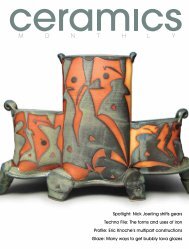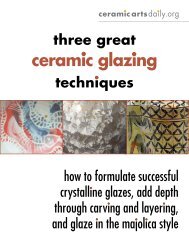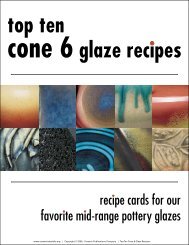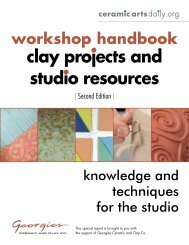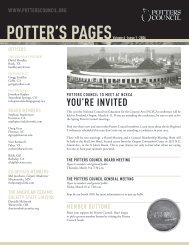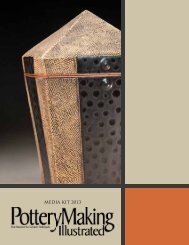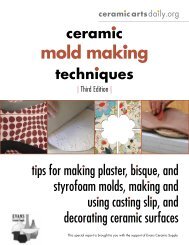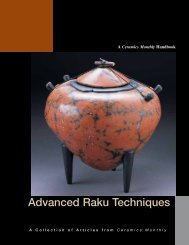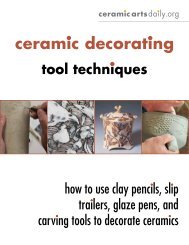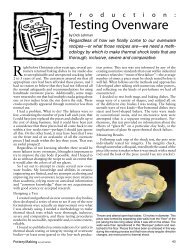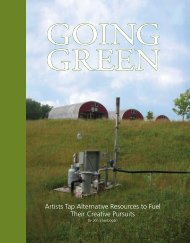stud io reference - Ceramic Arts Daily
stud io reference - Ceramic Arts Daily
stud io reference - Ceramic Arts Daily
You also want an ePaper? Increase the reach of your titles
YUMPU automatically turns print PDFs into web optimized ePapers that Google loves.
<strong>stud</strong><strong>io</strong> <strong>reference</strong> | glazes<br />
Imagine a glaze that fires perfectly<br />
at both cone 10 and cone 6, in<br />
reduct<strong>io</strong>n and oxidat<strong>io</strong>n, and in<br />
a soda firing, yet still produces a<br />
variety of exciting, stable colors. This<br />
idea intrigued me after realizing that<br />
one of the glazes in our <strong>stud</strong><strong>io</strong> fired<br />
well at cone 10 reduct<strong>io</strong>n in a gas kiln,<br />
cone 6 in an electric kiln, and cone 9<br />
reduct<strong>io</strong>n in a soda kiln without any<br />
change in the recipe. The glaze—<br />
Turner’s White—consists of common<br />
inexpensive ingredients that are easy<br />
to find.<br />
Addit<strong>io</strong>nally, this glaze has very<br />
good properties—great viscosity but<br />
not runny; applies very well on bisque<br />
whether you spray, dip or pour; and<br />
doesn’t settle out in the bucket over<br />
time so remixing is fairly easy.<br />
Turner’s White<br />
Dolomite . . . . . . . . . . . . . . . . . . . . . .10 %<br />
Whiting . . . . . . . . . . . . . . . . . . . . . . . .9<br />
Soda Feldspar . . . . . . . . . . . . . . . . . .25<br />
Custer Feldspar . . . . . . . . . . . . . . . . .20<br />
EPK Kaolin . . . . . . . . . . . . . . . . . . . . .18<br />
Talc . . . . . . . . . . . . . . . . . . . . . . . . . . .6<br />
Silica . . . . . . . . . . . . . . . . . . . . . . . . .12<br />
100 %<br />
Add: Bentonite . . . . . . . . . . . . . . . . . .2 %<br />
Zircopax . . . . . . . . . . . . . . . . . . . . .8 %<br />
Color tests (right)<br />
1 Copper Carbonate . . . . . . . . . . . . 4 %<br />
2 Copper Carbonate . . . . . . . . . . . .0 .6 %<br />
Tin Oxide . . . . . . . . . . . . . . . . . . . . .2 %<br />
3 Cobalt Carbonate . . . . . . . . . . . . . .4 %<br />
Lithium Carbonate . . . . . . . . . . . . . .2 %<br />
4 Rutile . . . . . . . . . . . . . . . . . . . . . . .8 %<br />
5 Red Iron Oxide . . . . . . . . . . . . . . . . .4 %<br />
Rutile . . . . . . . . . . . . . . . . . . . . . . . .4 %<br />
6 Mason Stain 6405 (Naples Yellow) 4 %<br />
Mason Stain 6433 (Praseodymium) 4 %<br />
Note: Tests 3, 4, and 6 applied over Turner’s White .<br />
Variat<strong>io</strong>ns on a glaze base<br />
by Kristina bogDanoV<br />
Feldspar EPK Silica Whiting Talc Dolomite Bentonite Zircopax<br />
Altering a glaze: The top two rows above were fired to cone 10 reduct<strong>io</strong>n in<br />
a gas kiln and the bottom two rows were fired to cone 6 electric. Rows 1 and<br />
3 contain 100 extra grams of the tested ingredient listed below each row, and<br />
rows 2 and 4 contain none of the tested ingredient.<br />
1 2 3 4 5 6<br />
The tiles above are examples of a single glaze base (Turner’s White) used to obtain<br />
a variety of colors by adding coloring oxides. The top row was fired to cone<br />
6 electric and the bottom row to cone 10 reduct<strong>io</strong>n in a gas kiln.<br />
www.ceramicartsdaily.org | Copyright © 2010, <strong>Ceramic</strong> Publicat<strong>io</strong>ns Company | 2010 Buyers Guide to <strong>Ceramic</strong> Supplies | 14



